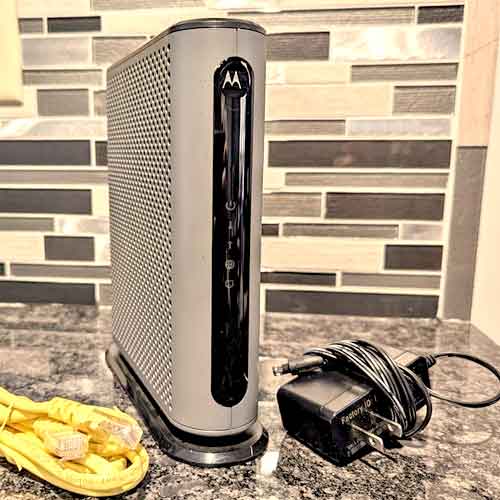Both cable modems are multi-Gig cable modems with just one 2.5Gbps Ethernet LAN port. They both meet the DOCSIS 3.1 standard to provide ultra-fast speed for gaming, streaming, and much more.

Neither of them has any built-in router in them but they do contain a similar chipset made by Broadcom.
And both of the cable modems can provide up to 2.5 Gbps downloading and 800 Mbps uploading speed with ipv6 standard protocol.
Heres the main thing to know:
- Their performance and durability are on an equal level.
- The design of CM2000 is more attractive and relatively better.
- CM2000 is costlier.
Compared to Netgear CM2000, the Motorola MB8611 is more economical. Otherwise, its performance and durability are equivalent to its competitor.
Table of Contents
Side By Side Comparison:
Overivew of both devices:
Netgear CM2000 delivers downloading data up to 2.5 Gbps and 1Gbps through 2 × 2 OFDM (A) DOCSIS 3.1 channel bonding and 32 × 8 SCQAM DOCSIS 3.0 channel bonding. It is compatible with all types of WiFi routers but is usually recommended for NETGEAR routers for better compatibility.
Compatible with all the internet service providers, the Motorola MB8611 is a very economical cable modem that provides 2.5 Gbps of internet speed. Similar to its competitor, it utilizes the same modulation methods to provide parallel internet speed.
It is also compatible with all types of WiFi routers.
Design and Hardware
Both of the contestants are vertical rectangle-shaped cable modems.
The base of Netgear CM2000 is shaped like a two-legged narrow stand, which gives it more stability compared to the other device whose base shape is elliptical.
Both of their front panels are equipped with a status indicating LED lights.
Their rear panels contain network, power, and cable interfaces.
Motorola 8611 is relatively larger in size and heavier in weight compared to its competitor. The network interface (Ethernet port) of it also has two LED lights for indicating its network status.
Both of them have only one Ethernet LAN Port which can support up to 2.5 Gbps. And both competitors do not contain any telephone jack or built-in WiFi router.
The only thing that differentiates their design is their bases which gives Netgear CM2000 relatively more stability on a surface. Besides that, their design and hardware are not that much apart from one other.
How compatible are these devices?
Both of the competitors meet many popular internet service providers all over the globe including Xfinity from Comcast, Cox, Spectrum, etc.
They are also compatible with almost all the major Internet Protocols including the latest one named IPv6.
It allows them to have practically unlimited addresses and makes the routing process more hierarchical and efficient.
Both of them are compatible with every type of WiFi router but Netgear CM2000 is considered to be more suitable for Orbi RBK852, AX120, and RAX200. Besides that, they are compatible with any Windows, Mac, gaming stations, streaming, and more.
Performance Comparison:
Since both of the contenders meet the DOCSIS 3.1 standard so they are sure to provide high downloading and uploading speed by utilizing advanced signal processing techniques.
But they are also compatible with DOCSIS 3.0 as well to provide a wide range of applications.
Both of our competitors utilize both of these modulation methods depending upon the DOCSIS standard. Their bonding channels are mentioned below.
As you can see that the bonding channels of the contestants in both modulation methods are similar.
So if a user chooses to utilize these devices over DOCSIS 3.0 or 3.1, both of these devices would provide the same amount of data transfer.
Both of them contain a BCM3390 Broadcom chipset that ensures a 50 percent of efficiency upgrade on present spectrum allocations.
Both of them have industrial-level lightning and surge protection in them to provide enhanced durability.
Since both of them have the same parameters from a performance perspective, then it is obvious that their performance and durability would be the same as well.

